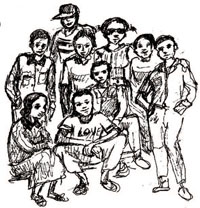Peer education programme
Peer education is the process whereby well-trained and motivated young people undertake informal or organised educational activities with their peers (those similar to themselves in age, background, or interests). A peer is a person who belongs to the same social group as another person or group. The social group may be based on age, sex, occupation, socio-economic or health status, and other factors.

Peer education is an effective way of learning different skills to improve young people's reproductive and sexual health outcomes by providing knowledge, skills, and beliefs required to lead healthy lives. Peer education works as long as it is participatory and involves young people in discussions and activities to educate and share information and experiences with each other. (Figure 12.3) It creates a relaxed environment for young people to ask questions on taboo subjects without the fear of being judged and/or teased.
What is a taboo subject?
Taboo refers to strong social prohibition (or ban) relating to human activity or social custom based on moral judgement and religious beliefs. In most of our communities openly talking about sex is considered unacceptable.
The major goal of peer education is to equip young people with basic but comprehensive sexual and reproductive health information and skills vital to engage in healthy behaviours.
Several areas of adolescent and youth reproductive health such as STIs (including HIV and its progress to full-blown AIDS), life skills, gender, vulnerabilities and peer counselling could be addressed in peer education. Although peer education is mainly aimed at achieving change at the individual level by attempting to modify the young person's knowledge, attitudes, beliefs or behaviours, it can also effect change at a group or social level by modifying existing norms and stimulating collective action.
Box 12.2 Advantages of peer education for young people
- Peer education helps the young person to obtain clear information about sensitive issues such as sexual behaviour, reproductive health, STIs including HIV
- It breaks cultural norms and taboos
- It is combined with training that is user friendly and offers opportunities to discuss concerns between equals in a relaxed environment
- Peer education training is participatory and rich in activities that are entertaining while providing reliable information
- Training in peer education offers the opportunity to ask any questions on taboo subjects and discuss them without fear of being judged and labelled
- Peer education as a youth-adult partnership: peer education, when done well, is an excellent example of a youth-adult partnership. Increased youth participation can help lead to outcomes such as improved knowledge, attitudes, skills and behaviours.
Peer education can take place in small groups or through individual contact and in a variety of settings: schools, clubs, churches, mosques, workplaces, street settings, shelters, or wherever young people gather. You will know from your own experience that young people get a great deal of information from their peers on issues that are especially sensitive or culturally taboo. Often this information is inaccurate and can have a negative effect. Peer education makes use of peer influence in a positive way.
As a health worker closely working with the community, you might be asked to give training on peer education to young people. However, before you are asked to train peer educators, you are likely to receive short-term training on how to train young people to be effective peer educators. Therefore, in this study session you will study only some basic tips that will help you in training adolescents to be peer educators. Firstly, young people, like adults, have a tendency to mask how much they don't know about a subject. Hence, you should not assume the topic is understood because there are no questions; ask questions of the participants when they do not offer their own. Secondly, young people and adults learn better if they are neither criticised nor judged by the facilitator. It is important to keep a positive attitude. Young people will learn better in an atmosphere of support, trust and understanding.
These basic tips will also be useful to the young people who you have trained to be peer educators. They will also want to know whether they should organise some activities or just be available to talk to peers, e.g. at school, work or in a bar.
After taking the training, a good peer educator should have the following qualities.
- Ability to help young people identify their concerns and seek solutions through mutual sharing of information and experience.
- Ability to inspire young people to adopt health seeking behaviours by sharing common experiences, weaknesses, and strengths.
- Become a role model; a peer educator should demonstrate behaviours that promote risk reduction within the community in addition to informing about risk reduction practices.
- Understand and relate to the emotions, feelings, thoughts and “language” of young people.
Examples of youth peer education activities include organised sessions with students in a secondary school, where peer educators might use interactive techniques such as role plays or stories, and a theatre play in a youth club, followed by group discussions. Theatre play in this sense doesn't mean that peer educators should be properly trained artists. It only refers to short dramas which are based on real-life experiences that young people are likely to face in their day-to-day life. Peer educators are also expected to use informal conversations with friends, where they might talk about different types of behaviour that could put their health at risk and where they can find more information and practical help.